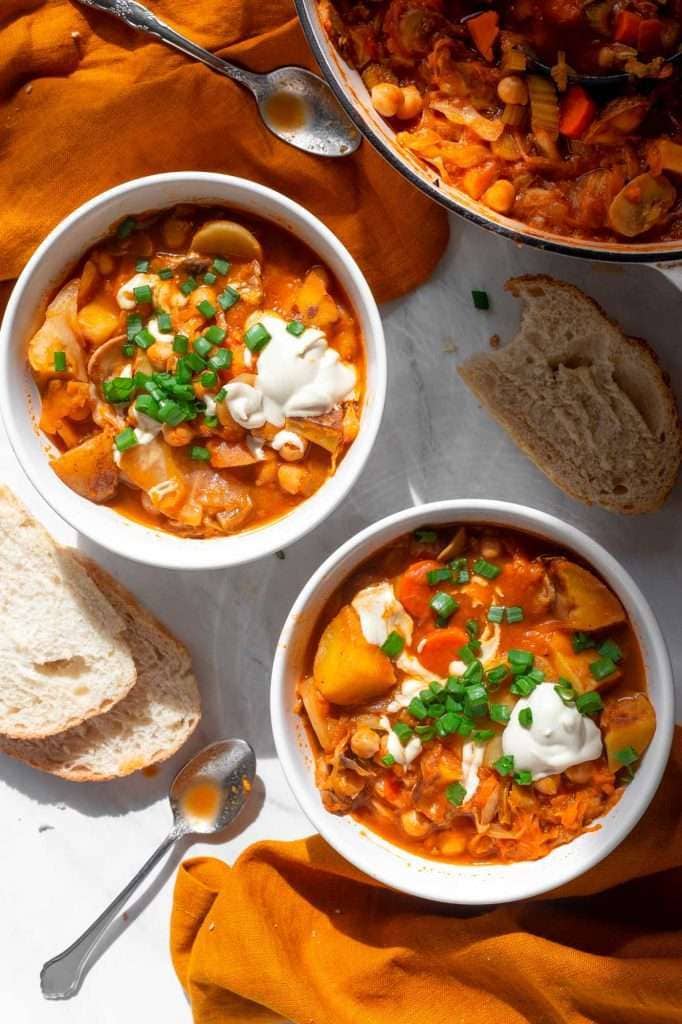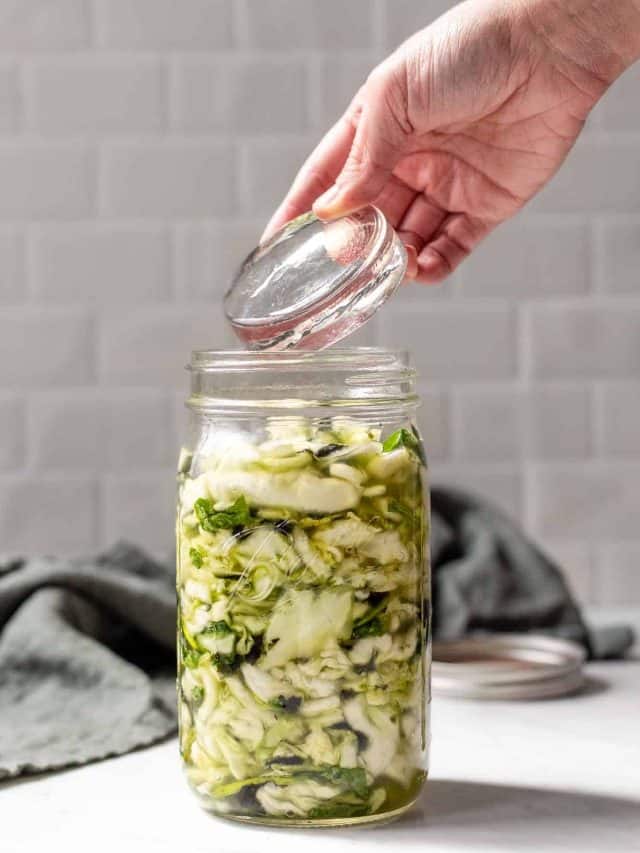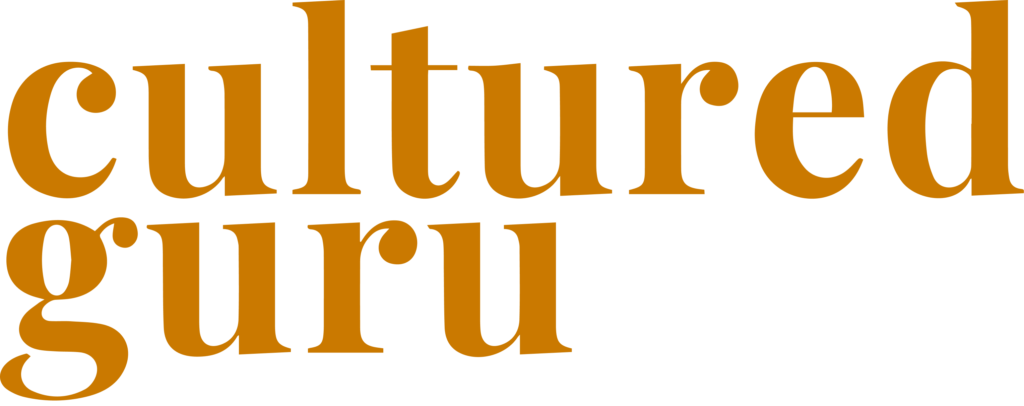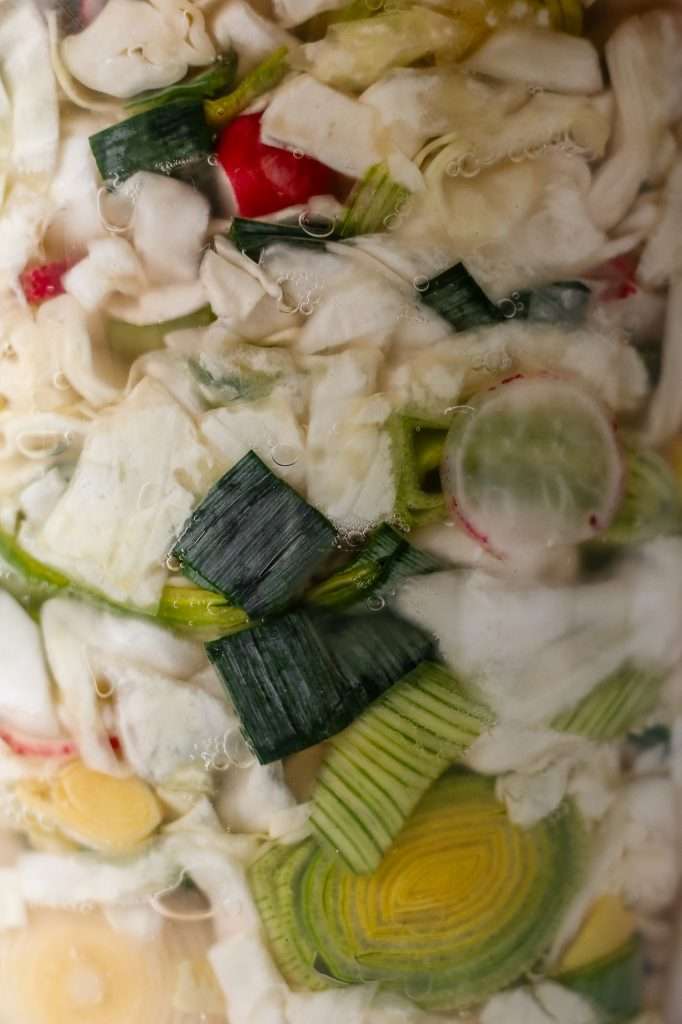What is the best probiotic to take for gut health? What are probiotics? What’s the difference between probiotics, prebiotics, and postbiotics? Check out this blog for all the answers!
I’ve been working on this blog for a bit, jotting down words I feel need to be defined on our website and blog. I wanted to write a long story-style blog as an introduction to gut health, but then I felt like this was a better approach.
There is so much to learn when it comes to the microbiome and gut health. There’s also so much more to learn when you start getting into fermenting vegetables and eating cultured foods to maintain gut health.


The best way to get started on a gut-healthy lifestyle is to learn the basics, and that starts with understanding the vocabulary. Many words fly around on our blog, on our Instagram, and out in the world about having a healthy gut. Here is our comprehensive glossary that’s a great crash course in understanding gut health.
- Microbiome:
- The ecosystem of microorganisms living inside and on complex organisms like animals, plants, bugs and humans.
- Flora:
- Same as microbiome. A term used to describe the microorganisms naturally in or on the body. Usually “flora” is used in reference to good microbes.
- Species:
- The most specific rank in taxonomic classification. For instance- Lactobacillus acidophilus is the scientific name of a probiotic bacteria. Lactobacillus is the genus the organism is classified in, a less specific rank. acidophilus is the species name, it’s like a specific subcategory within the Lactobacillus genus. Note: In proper notations, species names are NEVER capitalized and always italicized.
- Strain:
- A strain is not considered a taxonomic classification, but a strain is a subtype of species with specific characteristics.
- Prebiotic:
- Think of the population of microorganisms living in your gut as a pet… your pet microbiome. You have to give pets food and water to thrive right? Same goes for your microbiome, and the food you’re supposed to feed your microbiome is referred to as prebiotics. Prebiotic foods are plant-based foods rich in vitamins, minerals and fiber. Prebiotics are best for the microbiome when they are from fruits and vegetables.
- Probiotic:
- A probiotic is a microorganism introduced into the body for health benefits. Most often times, probiotics are bacteria and are also found in a healthy person’s microbiome.
- Postbiotic:
- Postbiotics are compounds made by probiotic microbes that can provide health and wellness benefits to the host. Postbiotics include vitamins, minerals, enzymes, amino acids. Basically, postbiotics are all the beneficial things produced by probiotics.
Let’s Recap, what is a probiotic and prebiotic again?
Recap: Probiotics are beneficial microorganisms → Probiotic microbes need PREbiotics to thrive within the body → When supplied, PREbiotics provide PRObiotics with everything needed to make POSTbiotics that are beneficial to the host.


Gut Health Vocabulary
- Dysbiosis:
- This is a term used to describe when the microbiome is off balance. Often used to mean that there is an imbalance causing more pathogens to be present.
- Leaky Gut Syndrome:
- Also called intestinal permeability. A condition that causes the lining of the intestines to not function properly. The intestinal lining does not work properly as a barrier and also does not work properly as an absorptive membrane for necessary vitamins and nutrients. Usually caused by food sensitivities and severe dysbiosis.
- Fermented Vegetables:
- Vegetable matter that is changed by bacteria over time, providing the most species rich, and natural source of probiotics in the world. Fermented vegetables are vegetables subjected to lactic acid fermentation of microbes. Through the process of lactic acid fermentation vegetables become probiotic, more nutrient dense and easier to digest.
- Wild Fermentation:
- When fermenting vegetables, the healthiest way to ferment is through wild fermentation. This is a fermentation technique in which salt concentration is used to set up selective living parameters of microbes. With these living parameters, probiotic microbes naturally living on vegetable matter are selected for to ferment the vegetables. It is a process that requires very specific salt concentrations and at least 3 weeks time.
- Probiotic Viability:
- The ability of a probiotic microbe to survive the digestive journey, outcompete pathogenic microbes, and survive in the presence of antibiotics. The most viable probiotic bacteria are found in wild fermented vegetables because they are more adapted to withstand acid and the digestive journey.
- Species Richness:
- Often wrongly confused with diversity. Species Richness is the amount of species present in an environment. The more species that are present the more species rich something is. So, the longer the list of microbes present in a probiotic supplement or a fermented food, the more species rich that supplement/food is. When eating foods and taking supplements for probiotic benefits, species richness is extremely important. The most species rich source of probiotics is properly wild fermented vegetables.
- Diversity:
- Wrongly used to describe species richness. Diversity is the evenness of species. For example in zoo #1 if I have one frog, one cat, one monkey, one bird and one fish I have a diverse environment. However, in zoo #2 if I have 14 frogs, 3 cats, 1 monkey, 70 birds, 197 fish, 300 ants, 5 cows, 7 ducks, 6 lions, and 9 seals… I do not have a diverse environment. In zoo #2 there are more types of animals, but it is not more diverse. This is because the amount of each type of animal is not even.
- So Zoo #1 is the most diverse but Zoo #2 is the most species rich.
- Antibiotic:
- A medicine that inhibits growth of, destroys, or weakens bacteria. Antibiotics can only be used to treat bacterial infections. Antibiotics cannot be used for viruses. However, antibiotics affect all bacteria, good and bad.
- Antibiotic Resistance:
- A prominent and developing problem due to the overuse of antibiotics by the agriculture and pharmaceutical industries. Pathogenic bacteria evolve constantly, and are now able to survive in the presence of multiple antibiotics. This is a huge problem because now we are unable to cure bacterial diseases that were curable with antibiotics 20 years ago.
- Biofilm:
- a population of microbes in a polysaccharide matrix that forms a film and strongly adheres to things.
- Microorganism:
- Refers to one microbe, and encompasses bacteria, fungi, viruses and sometimes parasites.
- Bacteria:
- Microscopic living organisms that are unicellular, have cell walls, and lack organelles. They are ubiquitous in our world… found in basically every environment known to man, even in the most extreme environments on Earth.
- Virus:
- A microscopic, infective entity not classified as a living thing. Viruses are too small to be seen by light microscopy and can only replicate inside the cells of living organisms.
- Fungi:
- a kingdom of taxonomic classification made up of Eukaryotic organisms that can be unicellular or multicellular. Includes microscopic molds and yeasts as well as mushrooms.
- Yeast:
- A single celled type of microscopic fungi. Yeasts reproduce by budding and metabolize sugars into carbon dioxide and alcohol.
- Lactobacillus:
- A rod shaped, Gram positive bacterium that produces lactic acid as a result of fermenting carbohydrates. Many species of Lactobacillus are considered probiotics, and many species can be found in properly wild fermented vegetables. Lactobacillus spp. are one of the main types of bacteria found in the digestive tract.
- Bifidobacterium:
- One of the main bacteria found in the digestive tracts of mammals. Also found in the vagina. Bifidobacterium are Gram positive, branching rod shaped bacteria that are used as probiotics.
- Helicobacter pylori:
- An acid tolerant, pathogenic, Gram negative bacteria that is found in the stomach of mammals and can cause stomach ulcers and stomach cancers.
- C. diff:
- Abbreviation for the bacterium Clostridium difficile. A serious antibiotic resistant pathogen. This bacterium is Gram positive, spore-forming, and toxin producing. 20% of antibiotic associated diarrhea is caused by this type of bacteria. This bacterium is also a promising focus in researching the cause of Autism.
- Candida:
- A genus of yeast (a type of fungi). Known to cause yeast infections world wide. Many species are found within the gut microbiome of humans and can become pathogenic. When exposed to large amounts of processed sugar Candida can overgrow and cause a diseased state, inflammation, and even sepsis.
- Lactic Acid Bacteria:
- A general classification of many types of bacteria that are able to produce lactic acid as a byproduct. This includes homolactic and heterolactic fermenters.
- CFU:
- Stands for colony forming units. A unit measuring the viable (living and able to replicate) microbes within a given amount of sample.
- Cultured Food:
- Any food product that has been enriched with a microbial population. The microbial population can occur naturally (as in wild fermentation) or the microbial population can be added to the food product (as in yogurt and cheese).
- Aerobic:
- Involving the presence of oxygen
- Anaerobic:
- involving the complete lack of oxygen. An anaerobic environment is very important in the fermentation of vegetables.
- Fecal Transplant:
- A method used to treat antibiotic resistant C. difficile infections. Involves transplanting a fecal sample of a person with a healthy microbiome into the intestines of a person with a C. diff infection.
- Plant Based Diet:
- Usually meaning vegan or vegetarian, but also pertains to anyone who derives most of their nutritional needs from plants. Eating a plant based diet is the best way to maintain gut health and balanced gut microbiome.
- Sequencing the Microbiome:
- Microbiomes are sequenced by collecting a sample from the environment to be studied. Then all of the DNA within the sample is extracted and analyzed using a database. Using the DNA from the sample, the analysis shows what identifiable microorganisms are present within the environment.
- Gram Positive:
- Refers to the cell wall structure of bacteria. Gram positive means that there is a thick peptidoglycan layer in the bacterial cell wall. This layer holds in crystal violet stain and appears purple when Gram stained for identification.
- Gram Negative:
- Refers to the cell wall structure of bacteria. Gram negative means that there is a much thinner peptidoglycan layer in the cell wall. These bacteria do not retain the purple stain when Gram stained for identification, they appear red (the color of the counter stain) instead.
- Bacterial Succession:
- The most important part of wild vegetable fermentation. Bacterial Succession is the process that results when vegetables are fermented properly. Bacterial Succession is when the growth and metabolism of one bacterial species increases, permanently altering the environment. This leads to the death of that species and the takeover of a different type of bacteria. As one type of bacteria dies off, the next species takes over until the ferment reaches a point with perfect living conditions for species of Lactobacillus (which are probiotic bacteria).



















